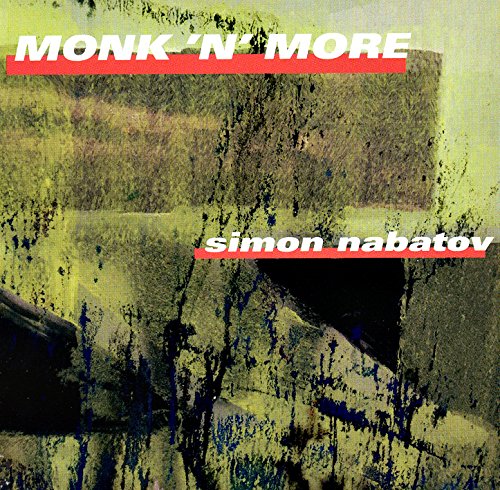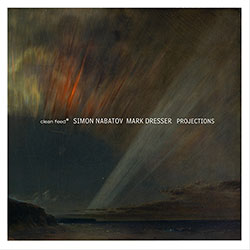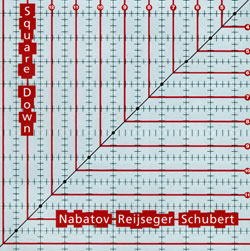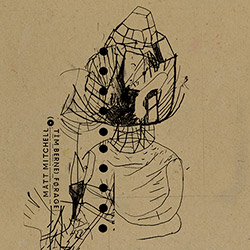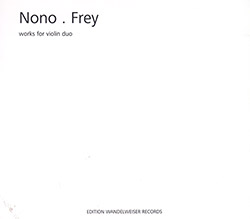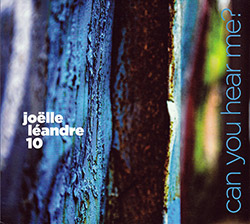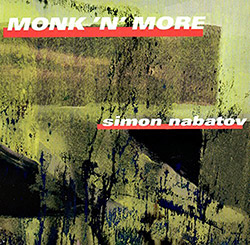
Pianist Simon Nabatov plays the music of Thelonious Monk in a live concert from 1995, alternating those recordings with a 2013 concert of solo electroacoustic work, an unusual approach that focuses the melodic aspects of Monk while highlighting his eccentricity and intrepidity.
Out of Stock
Quantity in Basket: None
Log In to use our Wish List
Shipping Weight: 4.00 units
Sample The Album:
Simon Nabatov-piano, electronics
Click an artist name above to see in-stock items for that artist.
UPC: 5024792078028
Label: Leo Records
Catalog ID: LEOR780.2
Squidco Product Code: 23314
Format: CD
Condition: New
Released: 2016
Country: UK
Packaging: Jewel Case
Recorded at the LOFT, in Cologne, Germany, in 1995 and 2013 by Christian Heck.
"As Stuart Broomer writes in his notes, the new Nabatov's recording consists of two solo recordings made 18 years apart, the first a selection of Thelonious Monk compositions from 1995, the second a concert from 2013 in which Nabatov first employed electronic technology in performance to create a pitch-bending, - expanding and - fracturing double of the piano. The result is a recording that explores time in multiple ways, whether looking at decades or cycles per second, treating the experience of chronological time as both malleable substance and a special kind of consciousness."-Leo
"Originally from the Soviet Union, pianist Simon Nabatov has built a very successful career, with many interesting projects as a solo pianist, collaborator and educator. This album consists of two solo recordings made eighteen years apart, the first a selection of Thelonious Monk compositions from 1995, the second a concert from 2013 in which Nabatov first employed electronic instruments in performance to create a doppelganger of the piano. There is an interesting dichotomy with the pieces from different instruments and time periods interspersed within one another. Nabatov has a natural and rich approach to the piano, beginning with an infectious version of Monk's "Skippy" that dances and sways, easing the listener into the pianists conception of music. There are four untitled tracks called "Electroacoustic Extension" which are his experiments into electronics. These can vary from using the electronics to develop a clipped rhythm, to selections that offer the sounds of a player piano in outer space. Nabatov isn't afraid to experiment, and if those selections start to intimidate the listener, he is quick to add further Monk interpretations, whether the more obscure "Oska T" to the familiar compositions "Epistrophy" and "Pannonica" where he draws on the melodic strength of the source material to create very appealing improvisations of his own. Monk warped space and time with his unique musical interpretations, and Nabatov does the same on his electronic experiments, bending and warping the fabric of the music and looking for new ways to approach sound. Moving back and forth with each approach can be startling, but it jars the listener out of complacency forcing them the take stock of Nabatov's approaches to both the familiar and the challenging sides of music."-Tim Niland, Jazz and Blues Blogspot
Get additional information at Jazz and Blues Blogspot
Artist Biographies
• Show Bio for Simon Nabatov "Simon Nabatov's musical education began at the age of 3, his father, himself a musician, being the first teacher. The Central School of Music and Moscow Conservatory were the next steps. After the whole family emigrated and settled in New York in 1979, Nabatov continued his studies at the Juilliard School Of Music. By that time his interest and involvement in jazz and improvised music grew strong enough to make them his main activity. Since then he performed and recorded with many fine musicians such as Paul Motian, Tony Scott, Sonny Fortune, Kenny Wheeler, Alan Skidmore, Herb Robertson, Louis Sclavis, Charles McPhearson, Billy Hart, David Murray, Paul Horn, Ricki Ford, Marty Ehrlich, Mark Dresser, Barry Guy, Gerry Hemingway, Jim Snidero, Herb Geller, Dave Pike, Attila Zoller, Matthias Schubert, Barry Altschul, Vladimir Tarasov, John Betsch, Ed Schuller, Arto Tuncboyaci, Adam Nussbaum, Paul Heller, Jay Clayton, Ron McClure, Mark Feldman, Drew Gress, Phil Minton, Michael Moore, Han Bennink, Misha Mengelberg, Wolter Wierbos, Paulo Alvares, Gareth Lubbe, Ben Davis and many others. He enjoyed continuous work with Ray Anderson Quartet, Arthur Blythe Quartet, Perry Robinson Quartet, NDR Big Band (Hamburg,Germany), Steve Lacy - Simon Nabatov Duo, Nils Wogram Quartet, Nils Wogram - Simon Nabatov Duo, Matthias Schubert Quartet, Matthias Schubert - Simon Nabatov Duo and Klaus König Orchestra. His own projects and activities included, since three decades, hundreds of solo recitals.In the early 90s Nabatov founded the trio with the bassist Mark Helias and the drummer Tom Rainey; the quartet "Nature Morte" with the British vocalist Phil Minton, multireed-player Frank Gratkowski and trombonist Nils Wogram (both from Germany); and the quintet including his trio plus the violinist Mark Feldman and the trumpet player Herb Robertson.In 2003 another trio was formed, with the cellist Ernst Reijseger and the drummers Michael Vatcher (and later Michael Sarin). As co-leader Nabatov played and recorded in duos with Steve Lacy, with the German tenor sax player Matthias Schubert, American drummer Tom Rainey, Dutch drummer Han Bennink, German trombonist Nils Wogram, Dutch cellist Ernst Reijseger and the Dutch pianist Misha Mengelberg, just to mention a few. His current duo partners are the South-African born viola player and vocalist Gareth Lubbe, the Turkish clarinetist Oguz Buyukberber and the Brazilian pianist Paulo Alvares. In the 1999-2000 season a large-scale radio production project (co - sponsored by WDR and Bayer AG) saw him write and record over 6 hours of music for solo piano, duo (with the American reed player Michael Moore), his trio, the quartet "Nature Morte" and the quintet. Beginning of 2000 the Swiss label HatHut Records brought out the first recording - the trio release "Sneak Preview". The next three recordings, quartet "Nature Morte", quintet "The Master and Margarita" and solo "Perpetuum Immobile" have been released by Leo Records. Two more CD´s - " Chat Room" ( duo with Han Bennink ) and "Autumn Music" ( trio with Ernst Reijseger and Michael Vatcher ) were brought out by this independent English label.The next project produced by WDR in 2004 was a 90 - minute piece " A Few Incidents" based on the texts of Russian writer Daniil Charms. The octet included Phil Minton, Frank Gratkowski, Nils Wogram, Ernst Reijseger, Cor Fuhler, Matt Penman, Michael Sarin and Simon Nabatov. Leo Records released the recording of this composition in 2005. Together with "Nature Morte" and "Master and Margarita" it completed the "Russian Trilogy", 3 musical projects based on the Russian literature. In 2009 Nabatov, sponsored by the Cologne culture institutions, completed a 5-day project called "Roundup" (involving M.Schubert, N.Wogram, E.Reijseger and T.Rainey), resulting in 3 CD's released on Leo Records: quintet "Roundup", a trio with E.Reijseger and M.Schubert - "Square Down" and another one with N.Wogram and T.Rainey - "Nawora". Starting around 2000, parallel to his jazz activities, Simon Nabatov developed a deep interest for the culture and music of Brazil. This led him to study the Portuguese language, travel number of times throughout the country and learn a great deal about a number of different musical genres. Some of the more structured activities in that field were a CD release "Around Brazil" on the ACT label (2006), and the two-months long Goethe-Institut "Artist-in-Residence" in Porto Alegre, which allowed Nabatov to learn more about the regional "musica gaucha". Since 2007 he often performs his solo program based on Brazilian music. In the recent years Nabatov also delved into the field of electronic music, learning MAX/MSP programming environment; in April 2013 he premiered his new solo program for piano and computer, developed together with the German composer and electronic music specialist hans w. koch. In December 2016 excerpts from this program made up a half of the program of his most recent CD "MONK 'N' MORE". Another musical adventure of the recent years was Nabatov's solo program dedicated to the music of the great jazz composer and pianist Herbie Nichols. Leo Records released a highly acclaimed CD of that program, and the PanRec label brought out a DVD.2015 saw Nabatov realize a four-part project "...still crazy after all these years" (celebrating 25 years in Cologne), which resulted in forming 4 new trios: with two young Cologne musicians Stefan Schoenegg and Dominik Mahnig, with Andre de Cayres and Rodrigo Villalon (dedicated to Brazilian music), with two giants of improvised music Barry Guy and Gerry Hemingway, and a trio with two string players, Gareth Lubbe (viola) and Ben Davis (cello). The first documentation of the project - Simon Nabatov Trio "Picking Order" was released August 2016 on Leo Records. Other 3 releases are planned for 2017. Simon Nabatov performed and recorded numerous pieces of chamber music, some of them written specially for him: "Piano Concerto "Baba" by the American pianist/composer Kenny Werner, "Sonata for violin and piano" by the Irish bassist/composer Ronan Guilfoyle,"Trumpet Sonata", "Cello Sonata", "Trio for flute,cello and piano" by the Swiss reed-player/composer Daniel Schnyder. He also performed and recorded some of the more known "crossover" works, such as "Rhapsody in Blue" by George Gershwin (NDR Symphony Orchestra Hannover,1998) or "Concerto for Jazz Ensemble and Orchestra" by Rolf Liebermann (NDR Symphony Orchestra and Big Band, Hamburg,1996). Nabatov was among the winners of the 3rd "International Great Jazz Pianist Competition" in Jacksonville, USA (2nd prize) in 1985, and of the "Martial Solal International Jazz Piano Competition" in Paris, France (3rd prize) in 1989. In 1987 he was awarded a grant from the National Endowment for the Arts (NEA). Simon Nabatov made numerous radio productions for most of the major European broadcasting companies: WDR, NDR, HR, BR, SFR, Radio France, Radio Zürich, Radio Ireland etc. He played on countless international jazz festivals including Paris, Antibes, Helsinki, Zagreb, Nevers, Berlin, Dublin, Cork, Vilshofen, Bergamo, Groeningen, Vilnus, Karlsbad, Genua, North Sea, Brugge, Voss, Bergen, Riga, Vilnius, Ulrichsberg a.m.o. Simon Nabatov gave concerts and workshops in over 60 countries, he appears on ca. 70 recordings, and his own music and projects are documented on over 25 CD's and 3 DVD's (all DVD's on PanRec). He has taught at the Folkwang Hochschule (Essen), Musichochschule Lucerne (Switzerland) and at the International Jazz and Rock Academy (Remscheid).2012 - 2014 he was the substitute professor of Jazz piano and Ensemble at the Conservatory of Hannover, Germany. Since 1989 he resides predominantly in Cologne, Germany, but keeps an apartment and a part of his heart in New York." ^ Hide Bio for Simon Nabatov
4/22/2024
Have a better biography or biography source? Please Contact Us so that we can update this biography.
Track Listing:
1. Skippy 6:31
2. Electroacoustic Extension 1 6:06
3. Oska T. 4:33
4. Electroacoustic Extension 2 6:17
5. Pannonica 6:37
6. Electroacoustic Extension 3 5:10
7. Light Blue 6:12
8. Electroacoustic Extension 4 5:22
9. Sunrise Twice Redux 14:23
10. Epistrophy 6:21
Improvised Music
Jazz
Free Improvisation
Electro-Acoustic
Electro-Acoustic Improv
Piano & Keyboards
Solo Artist Recordings
Leo Records
Staff Picks & Recommended Items
Search for other titles on the label:
Leo Records.


